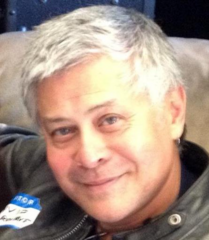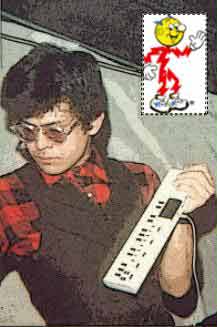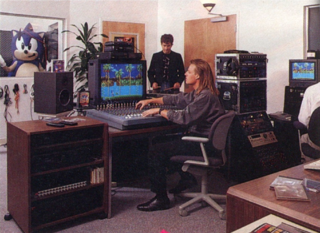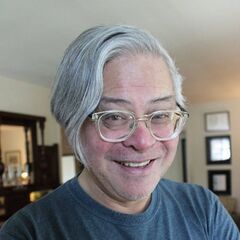David Javelosa
From Sega Retro

|
| David Javelosa |
|---|
| Place of birth: San Jose, California, United States[1] |
| Employment history:
Divisions:
|
| Role(s): Audio Director[2], Composer[7], Sound Designer[8] |
| Education: San Jose State University (1972-1976; BA Electronic Music)[8], California Institute of the Arts (1989-1992; MFA Composition - Computer Music)[8][1] |
David "Dave" Javelosa is an American musician and former Sega of America audio director, composer, and sound designer.[2] An accomplished early electronic artist, he first began working with Sega as a contractual consultant in October 1989[3][4], and was soon tasked with providing the music for some of the company's earliest domestic Genesis releases. He would eventually be hired full-time in 1992[2] and quickly became head of the newly-created Sega Multimedia Studio.[6] His responsibilities covered the management of Sega's audio production capabilities[3], the hiring of talented musicians to support the Sega CD, and working with Sega-licensed developers to provide support for the company's audio development tools.[7] During this time, he also composed music for the Sega Channel, as well as the first revision of the North American Sega CD BIOS.[9][10]
After departing his full-time position in 1994[2] and leaving his consultant position with Sega two years later[3], he remained active in the game industry as a freelance composer and audio director. In September 2001, he became a Professor of Interactive Media at Santa Monica College - a position he remains in to this day.[2] He also runs the independent music label Hyperspace Communications, which specializes in releasing electronic, new wave, and game music on vinyl records[7][11], and still creates FM synthesis to this day.
Contents
Career
Background
Born into a musical family, David Javelosa first learned to play the piano at a young age. His first piano instructor introduced him to classical recordings, particularly Beethoven symphonies, while the popular music of the era fascinated him in its early use of analog synthesizers. Javelosa first studied at San Jose State University, where he worked in the electronic music lab with an old Buchla 100 modular system and EMS Synthi AKS synthesizers. "I felt that the future of composition was in dynamic timbres; beyond pitch, rhythm, and arrangement. Electronic instruments made this happen."[13] He later went on to California Institute of the Arts, which saw him studying alongside Morton Subotnick, David Rosenboom, and other notable composers.
In his youth, he was an active musician, co-founding the New Wave band Los Microwaves[14] in December 1978 (playing analog synthesizers and providing vocals under the nickname "Microwave")[4], as well as establishing the independent label Hyperspace Communications that same month. During this time, he had established himself as a professional music producer[6], and was introduced to MIDI and computer sequencing.[13] It was during his early musical performances that Javelosa first developed an interest in video games, reportedly playing venue's arcade games to kill time between shows.[15]
His first MIDI synthesizers were Casio CZ-101s driven by a Commodore 64. "Some of the bands I worked with were into the Yamaha DX7, the first big breakthrough FM synth. I didn't like them at first because of the difficulty in programming and the expense. But soon there were more affordable versions, and with out keyboards due to MIDI control." His first FM synthesizer was the Yamaha TX81Z, a single rack module with multi-timbrel ability, which he began using in both the studio and during live performances. Javelosa attributes this experience to what first caught the attention of an industry friend.[13]
Sega of America
In October 1989[4], Javelosa was first approached by his friend and fellow musician Alex Rudis ("the godfather of Atari Lynx music", whom Javelosa had known from San Francisco's new wave scene back in the 1980[6]), who was then working with Sega of America. In particular, Rudis had been tasked with evaluating the pre-GEMS sound driver, the Sega Music Development System, but was overwhelmed with all the projects he had taken on, and could not find another musician that had the cross-section of skills for creating game audio. He also knew that Javelosa could program FM-based synthesizers and edit MIDI in command line editors, and reached out to him for assistance: first introducing Javelosa to the video game industry, and to Sega.[6]
Officially hired to Sega of America's domestic Product Development Team by its founder Ken Balthaser that October[4], Javelosa spent the next nine months working remotely from Los Angeles, but as he was still completing his MFA degree at California Institute of the Arts (and producing musical CD-ROMs for Voyager Company), producer Ed Annunziata had to fly the musician in from Los Angeles to Redwood City on the weekends.[7]
While he and other audio staff eventually prototyped a demo for the Music Development System, it was found to be too inconvenient to be widely used, and the project was ultimately dropped.[7] More importantly, however, Javelosa would compose music for Sega of America's earliest domestically-produced Genesis games, such as M-1 Abrams Battle Tank and 688 Attack Sub. On the FM to Genesis process, Javelosa recalls that, "before [the introduction of] GEMS, all my FM patches were transcribed by SOJ or in house at SOA." During this time, composer Mark Miller reached out to Javelosa for assistance in finishing Spider-Man vs. The Kingpin, where he ended up writing the game's title track. "Porting patches from the TX81Z to the Genesis engine was simple enough but had to be done manually. The main difference in the two chips was the Genesis could not do multiple wave shapes like the TX."
| “ | Writing for the Genesis was like doing a small instrumental ensemble, musically speaking, because you only had six voices to work with. But when those six voices were FM synthesizers, I could really go wild in creating new and interesting sound within the context of the games. I enjoyed writing for the cartridge machine almost more than the tracks I produced for CD. I was never really a traditional commercial composer. | „ |
— David Javelosa[6] | ||
When it came to producing music for the Genesis, Javelosa found the hardware difficult to program for. Worse, the system's output amplifier often made the music sound worse. He recalls that half the producers on staff were playing games on televisions with poor or blown-out speakers, with frequent complaints about the quality of the sound. Eventually, management upgraded them to Philips televisions, and "all of a sudden our music started sounding better." Regardless, Javelosa states that the YM2612 was an excellent sound chip, and that developing music for the Genesis was made easier by the abundance of tools and talent in the realm of FM synthesis. He even developed his own tool, a program which translated patch information from a Yamaha synthesizer to the Genesis, to ensure his music sounded just the way he composed them when later converted to FM.[6] Javelosa's work with the Genesis sound chip did not end at work, as he eventually began incorporating the system into his Santa Monica studio, reportedly "surrounded by bits and pieces of torn-apart game consoles, trashed Casios and forgotten keyboards."[16]
Sega Multimedia Studio
In late 1991[17], Ken Balthaser established Sega Multimedia Studio in an attempt to refocus the company's internal development capabilities around the CD-ROM and the upcoming Sega CD. Soon after in early 1992[13], the Product Development Team had its audio department officially migrated to the studio, with Javelosa soon being hired as the division's first full-time audio employee. He attributes his CD production experience at Voyager Company, along with his previous compositions and technical work, to his later hiring as a full-time employee. Reportedly, Sega of America was just starting to ramp up CD-ROM development to support the Sega CD with domestic software, and Javelosa was the perfect man for the job.[6]
As Sega of America's first full-time Sound Director[6], Javelosa was responsible for supporting first and third-party game developers with both tools and talent, including the hiring of sound programmer Brian Coburn, programmer Tom Miley, musician Spencer Nilsen, and audio engineer Barry Blum. "I needed a range of talent that spanned CD quality recording and really interesting sound design and these guys pretty much defined that."[6] With the example of Miley, all of these developers also doubled as composers, creating music for the company's games. On some occasions, Javelosa would recommend artists from his own references, while other times, producers would find their own talent and Javelosa's audio group would support them with the needed development tools.[7] He also reached out to fellow musician Fletcher Beasley (whom he had known from his time at Voyager Company) and referred him to Western Technologies, where he was eventually given a full-time role as the company's Audio Director.[18]

One of his first projects as a full-time employee was to compose music for the first revision of the upcoming Sega CD.[9][10] One of his first hurdles was handling the hardware's use of sampled sound, particularly in regard to combining the sound with the Genesis' FM synthesis. Working on the system was described as challenging, as despite the Genesis being engineered with future extensions in mind, the systems couldn't truly be linked to an optimal degree. Javelosa describes the system as "two game consoles that were just linked together", with which he would have to synchronize his sound between. Regardless, Javelosa sought to take advantage of the system's audio capabilities; the resulting piece was composed specifically to utilize both sound technologies, with the drums and strings being played in PCM, and the brass and bass in FM.[6]
Another hurdle was the concept of having the Sega CD make calls to different data on the disc. With the way the system handled CD audio, the hardware would have to switch between the CD and running the game loaded into memory; [it] was always a shot in the dark, whether it was working exactly in sync." Regardless, Javelosa eventually grew proficient in accounting for the system's lag time and memory deficiencies. He recalls that while CDs offered an entirely different experience from chip music, they lack the interactivity of traditional video game music, and that he preferred the challenge of making good Genesis music over a typical CD track. "For me, that was the coolest thing about it, creating interactive music, having a live synthesizer in the gameplay was what that was all about for me."[6]
Javelosa describes his initial responsibilities as being vague ("Seriously, everything was being made up on the spot in those days"), with much of his audio staff lacking dedicated roles; instead, they were generally tasked with handling anything and everything audio-related. To sour matters, Sega of America's musicians were frequently credited only for sound programming, as in Javelosa's own words, "it's only because the producers looked at our sound tools as middle-ware for the programmers. We had to make music and implement with the engineers."[7] Regardless, Javelosa continued to surround himself with talent audio staff from varied disciplines, eventually forming the core Sega Multimedia Studio team.[6]
In the studio's early days, Javelosa was responsible for purchasing equipment, consulting on studio construction, and hiring an audio team. He was also expected to continue creating music, sound effects, and even voiceover work. He was officially promoted to Senior Music Designer[8] in 1994[6], hired by Ken Balthaser to "turn the Studio into something never before seen at Sega, or any other hardware manufacturer, to this point."[19] Much of his work during this time entailed music supervision; connecting Sega's producers and video games with internal and external composers.[6]
As Multimedia Studio was now responsible for managing the music production of Sega's Western game output (including those developed both in-house and externally[3]), Javelosa occasionally found himself with other responsibilities, including acting as a liaison between Sega of America and its two biggest co-branches, Sega of Japan and Sega Europe.[3]
Despite essentially functioning as the studio's music director, management refused to give him a "Director" title (giving him a "Manager" title), and Spencer Nilsen was promoted to Director of Sega Music Group instead. Following this, Javelosa's Multimedia Studio team was split into three branches around 1994: Nilsen's Sega Music Group, Javelosa's group (now known as Creative Support), and Developer Technical Support.[6] It was around this time Javelosa began contemplating going freelance and returning to Los Angeles.[13]
| “ | It’s a balance. Some people say it’s all about composing the music, and some say it’s about knowing the technology. I think it’s both. You have to have an understanding of both, and sometimes it’s a risk. You don’t find a lot of opportunities where that intersection meets, and you don’t meet a lot of people who kind of understand both sides of it. | „ |
— David Javelosa[6] | ||
Regardless of any setbacks encountered with management, Javelosa ensured his newly-christened Creative Support would be fully staffed with a diversity of talent. "It was basically the five disciplines of game development: we had programmers, artists, designers, audio people, and the producer." Creative Support was set up to support outside game developers, while what remained of Multimedia Studios worked on internally-developed games. Despite these intentions, Javelosa frequently found himself going back and forth between both teams.[13] Ed Annunziata was once set to serve as Creative Support's first producer, but realized that he wasn't able to exert as much creative control with an internal development group as he did with third-party developers, and declined the position. Regardless, Javelosa is proud of his experience with the Multimedia Studio team, recalling "we pretty much took the 16-bit processor as far as it could go, the 16-bit Motorola was not quite powerful enough to bring as much out of the CD-ROM as it could."[6]
Javelosa would leave his full-time position with the company in September 1994. He recalls almost accepting a music specialist role at Developer Technical Support before departing, but "saw the writing on the wall" and left the company to return to Los Angeles.[6] He remained as a contractual consultant for Sega until 1996[3], mostly working on his previous in-development titles like the Sega Channel and Iron Hammer. During this time, he was also freelancing for a number of other game developers, such as creating music for Marvel Entertainment's CD-ROM-based comic books.[9] His final Genesis work would be the third-party titles Aaahh!!! Real Monsters and Pocahontas.[13]
Later career
| “ | At one point I just realized that the reasons I came to Sega were no longer valid. I also realized that most of the freelancers that I was supporting in creative support were doing fine on the outside, so I thought I’d go on the outside and work as an independent developer. I had already started writing and teaching, so I took all those connections to LA with me and ended up writing a book and teaching at UCLA. | „ |
— David Javelosa[6] | ||
Following his departure from Sega of America, Javelosa acted as a freelancer for companies such as Nintendo, Sony, and Electronic Arts (including Microsoft, for which he provided sound and director for the company's Spoken World and Dreamsheet online series[3]), all while continuing his publishing work and electronic media consulting. In 1997, he authored the book Sound & Music for Multimedia, which details the history and specifications of major computer and video game systems, how to handle tools like MIDI, and the incorporation of audio production in regard to game development.[20] He would remain a freelancer until 1999, when he was hired by Yamaha Corporation as their in-house game industry specialist. He would stay at Yamaha for the next three years, expanding the company's dominance of the game audio hardware and software markets (particularly in regard to the PlayStation 2, and acting as an advisor on the particulars of the American game industry.
Javelosa first began educating in 1993, teaching at venues such as San Francisco State University Multimedia Studies Center and University of California, Los Angeles's Entertainment Studies Program, among others.[20] About a year into his 1993 course at San Francisco State, Kurt Harland attended one of his audio design courses. Javelosa introduced him to Mark Miller, who eventually hired the young musician.[21]
Since September 2001, Javelosa has served as a full time Professor of Interactive Media in the Design Technology Department at Santa Monica College’s Academy of Entertainment and Technology[2] (currently known as The Center for Media and Design), where he also founded a dedicated game development program in the Fall of 2004.[20] His acceptance was reportedly a major hiring point for Santa Monica College, as the university had wanted to hire industry talent for some time. Javelosa also runs the independent music label Hyperspace Communications, which specializes in releasing electronic, new wave, and game music on vinyl records - including publishing his previous work.[7][11] Javelosa's music has also been released on the labels Dark Entries Records[22] and Section 9, the latter of which published dedicated Sega Channel and Sega CD releases in July 2023.[23][24]
Javelosa is also a licensed United States Parachute Association skydiver[8], an established author for trade publications like Interactivity Magazine and Film Music Magazine[20], and a former chair of the game audio-focused IASIG Education board.[25] He has also spoken at events like the annual Game Developers Conference, as well as for organizations like the Audio Engineering Society.[20] Javelosa plans to continue teaching until late 2024, and still creates FM synthesis to this day.[6]
Legacy
Javelosa retained his DJ Demo Reel cartridge following his time with Sega, and later reused its contents for teaching material once he began his teaching career. During one of his 2019 courses at Santa Monica College, a student recognized the importance of said material[26] and eventually persuaded him to upload a recording of the cartridge's ROM to YouTube that May.[27] This, along with Javelosa's active presence in the video's comment section, revealed new information related to a number of Sega of America's more notable projects.
Quotes
| “ | Some have said that game music is over; meaning that there is nothing more that can be done, technically speaking. But because my background was in experimental composition, I’ve always looked for the next cool thing in music technology. The buzz about “procedural music” in EA’s Spore is an example. Using software to generate unique musical experiences is something I have pursued for a long time. Also creating “interactive” music and sound engines that change with the game play is something that has yet to be fully explored. Some composers argue that the audience really can’t tell the difference. But just listen to Halo whey you play it. You can’t put your finger on it, but you know that something different is happening. | „ |
— David Javelosa[6] | ||
Production history
- M-1 Abrams Battle Tank (Mega Drive; 1991) — Composer
- 688 Attack Sub (Mega Drive; 1991) — Composed by
- Spider-Man vs. The Kingpin (Mega Drive; 1991) — Music and Effects[28] (as Dave Javelosa)
- Mario Lemieux Hockey (Mega Drive; 1991) — Music/Sound[29]
- Dr. Robotnik's Mean Bean Machine (Mega Drive; 1993) — Sound[30]
- Dr. Robotnik's Mean Bean Machine (Game Gear; 1993) — Sound Programmers[31]
- Sonic the Hedgehog Spinball (Mega Drive; 1993) — Special Thanks[32]
- Dr. Robotnik's Mean Bean Machine (Master System; 1994) — Sound Programmers[31]
- Streets of Rage 3 (Mega Drive; 1994) — Special Thanks to[33]
- Ecco: The Tides of Time (Mega Drive; 1994) — Music[34]
- Jurassic Park (Mega-CD; 1993) — Sound Manager[35]
- Aaahh!!! Real Monsters (Mega Drive; 1995) — Additional Music and Sound Effects (as Dave Javelosa)
- Pocahontas (Mega Drive; 1996) — Production Support[36]
- Baby Boom (Mega Drive; unreleased) — Composer
- DJ Demo Reel (Mega Drive; unreleased) — Composer
- Iron Hammer (Mega Drive; unreleased) — Composer
Interviews
- Interview: David Javelosa (2008-07-02) by Sega-16
- Interview: David Javelosa (2023-11-12) by Alexander Rojas
- Interview: David Javelosa (2023-12-09) by Alexander Rojas
Photographs
- Main article: Photos of David Javelosa
External links
References
- ↑ 1.0 1.1 https://www.facebook.com/javelosa.david
- ↑ 2.0 2.1 2.2 2.3 2.4 2.5 2.6 2.7 2.8 2.9 https://www.linkedin.com/in/david-javelosa-a6a1171/details/experience/
- ↑ 3.0 3.1 3.2 3.3 3.4 3.5 3.6 3.7 3.8 http://javelosa.com/DJ/consulting.htm (Wayback Machine: 2022-08-16 18:34)
- ↑ 4.0 4.1 4.2 4.3 4.4 https://www.facebook.com/javelosa.david/about_work_and_education
- ↑ File:SegaofAmerica ProductDevelopmentTeam 3.png
- ↑ 6.00 6.01 6.02 6.03 6.04 6.05 6.06 6.07 6.08 6.09 6.10 6.11 6.12 6.13 6.14 6.15 6.16 6.17 6.18 6.19 6.20 6.21 6.22 Interview: David Javelosa (2008-07-02) by Sega-16
- ↑ 7.0 7.1 7.2 7.3 7.4 7.5 7.6 7.7 Interview: David Javelosa (2023-11-12) by Alexander Rojas
- ↑ 8.0 8.1 8.2 8.3 8.4 https://www.linkedin.com/in/david-javelosa-a6a1171/
- ↑ 9.0 9.1 9.2 http://javelosa.com/DJ/production.htm (Wayback Machine: 2022-12-25 00:07)
- ↑ 10.0 10.1 https://www.youtube.com/watch?v=pKLKquCbzJ4 (Ghostarchive)
- ↑ 11.0 11.1 https://www.facebook.com/HyperspaceCommunications/
- ↑ http://javelosa.com/DJ/davidMicrowave.htm
- ↑ 13.0 13.1 13.2 13.3 13.4 13.5 13.6 Interview: David Javelosa (2023-12-09) by Alexander Rojas
- ↑ http://javelosa.com/DJ/Los_microwaves.htm (Wayback Machine: 2023-05-28 20:23)
- ↑ https://www.oreilly.com/pub/au/3122 (Wayback Machine: 2023-11-13 16:38)
- ↑ https://darkentriesrecords.bandcamp.com/album/david-javelosa-31st-century-lounge-music (Wayback Machine: 2023-11-29 15:46)
- ↑ K Horowitz (2016). Playing at the Next Level: A History of American Sega Games
- ↑ K Horowitz (2016). Playing at the Next Level: A History of American Sega Games
- ↑ K Horowitz (2016). Playing at the Next Level: A History of American Sega Games
- ↑ 20.0 20.1 20.2 20.3 20.4 http://javelosa.com/DJ/edupub.htm (Wayback Machine: 2022-08-16 18:31)
- ↑ K Horowitz (2016). Playing at the Next Level: A History of American Sega Games
- ↑ https://www.darkentriesrecords.com/store/music/vinyl/lp/baby-buddha-music-for-teenage-sects/
- ↑ https://section9tapes.bandcamp.com/album/sega-channel
- ↑ https://section9tapes.bandcamp.com/album/sega-cd
- ↑ https://sonicretro.org/2019/05/15/david-javelosa-sonic-and-sega-music-demo-tracks-surface-online/ (Wayback Machine: 2023-03-26 08:15)
- ↑ https://www.youtube.com/watch?v=rJLkkOxRP8Y (Ghostarchive)
- ↑ File:Spider-Man vs the Kingpin MD credits.pdf
- ↑ File:Mario Lemieux Hockey MD US Manual.pdf, page 16
- ↑ File:Dr. Robotnik's Mean Bean Machine MD credits.pdf
- ↑ 31.0 31.1 File:Dr. Robotnik's Mean Bean Machine SMS credits.pdf
- ↑ File:SonicSpinball MD US manual.pdf, page 21
- ↑ File:Streets of Rage 3 MD credits.pdf
- ↑ File:Ecco The Tides Of Time MD US Manual.pdf, page 30
- ↑ File:Jurassic Park MCD credits.pdf
- ↑ File:Pocahontas MD credits.pdf


